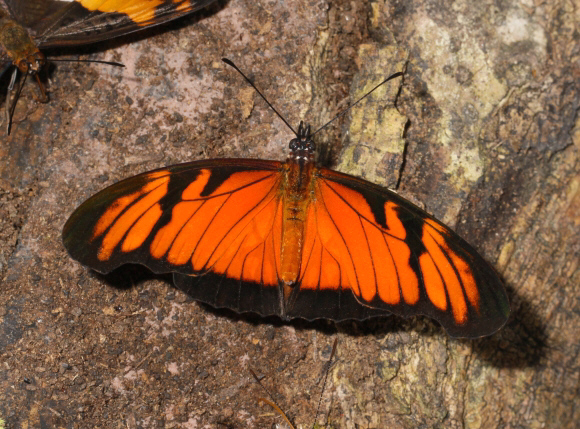
Dione juno (Dione juno)
Phylum — arthropoda
Class — insecta
Order — lepidoptera
Family — nymphalidae
Genus – dione
Appearance
The dorsal wing surface is a brilliant reddish-orange edged and veined with black. The wing underside is light reddish-brown and patterned with silvery-white streaks and spots. Each ventral forewing has a large light orange patch.
Habitat
Dione juno is distributed from Mexico to Paraguay.
Behavior
This species, like others in the genus, is migratory in behavior, so can be found in many habitats, and at any altitude up to 2000 meters, but is commonest in disturbed forest between 200-800m. It is usually encountered in sunny areas by riverbanks, rocky slopes or roadsides.
The male is usually encountered singly imbibing moisture from puddles or ditches. Females tend to be seen mainly when nectaring at Lantana and other shrubs.
The adults fly quickly and erratically.
Lifecycle
The eggs are bright yellow at first, later becoming red, and are laid in batches on the leaves and stems of Passiflora (Passifloraceae). Mature caterpillars are black and covered in orange spots and black spines. They live gregariously and moult in synchronization. The chrysalids are wrinkled and brown, and, when hung from branches, look like dead leaves.
In captivity
To make the butterfly active, it is necessary to maintain the temperature in the room at the level of 23-30 oC. The butterfly can live at lower temperatures, even at +15 oC, but it will be sleepy and inactive. If the temperature rises, the butterfly will be active again.
It is necessary to spray the butterfly several times a day with clean water at room temperature from the flower sprayer. And if you have a steam humidifier, then it's great! With the help of it you can maintain high humidity in the room. If you do not have a sprayer or a humidifier, you can simply moisten your hands with water and spray on the butterfly.
Butterflies are very fond of light and being indoors, they will always strive for its source. In this regard, the following rules should be observed:
1) Close the windows in the room where the butterfly lives.
2) Slide the tulle so that the butterfly does not beat against the glass (this will save the wings).
3) If the room has a chandelier with lampshades in the form of a bowl turned up, do not turn it on. A butterfly can die by flying in there.
At home the butterfly must be fed once a day. You can also do it 2-3 times if you see that the butterfly has stuck out its proboscis and is looking for something. That means it's hungry. You can feed it with water with natural honey /homemade jam: dilute one spoonful of honey/jam in a glass of water and slightly pour the resulting mixture into a saucer or into another shallow container with low edges, and best of all on a wooden surface, such as a cutting kitchen board, so that the butterfly can safely cling to its legs and not slip.
To feed a butterfly, you need to bring a saucer with a mixture or a piece of fruit to the butterfly. There are special taste buds on the front legs of the butterfly so when you feel the sweet smell, the butterfly itself will stick out its proboscis and start eating.
At night, the butterfly can be placed in a box with a piece of wet cloth or sponge inside, or left to sleep on a wall or curtain.
 Russian
Russian
 English
English























